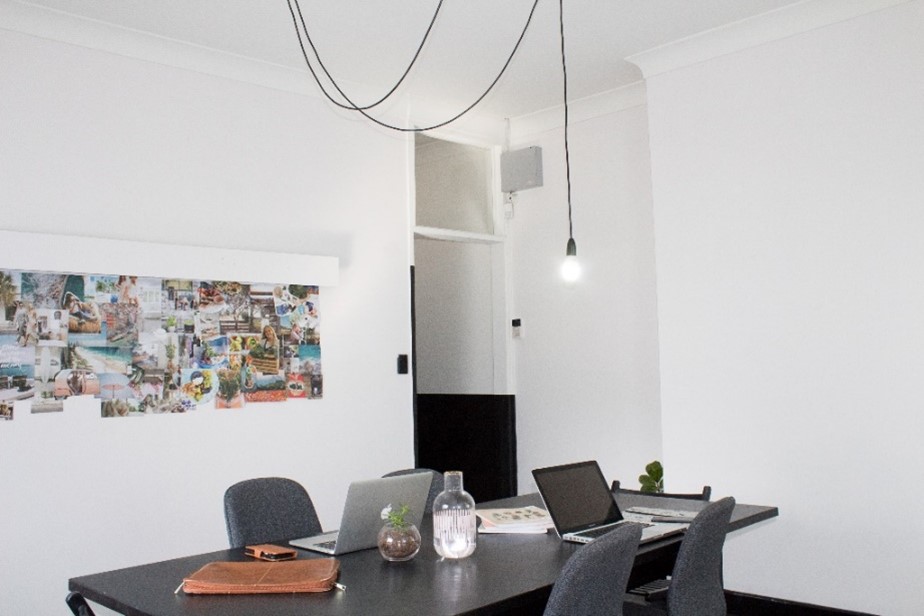WDM follows up with Gemma Riberti after her recent virtual NeoCon presentation which investigated the opportunities and challenges in designing for the new office ecosystem.
It is only fitting that theMart’s spring NeoCon programming kicked off with the theme: A Return to Togetherness: Designing the Next Workplace. This was not only most relevant to where we all are in the current affairs, but also as Work Design Magazine launches the second iteration of The 2021 Next Work Environment Competition.
Here is our recap of the first presentation, The Office as an Ecosystem, presented by Gemma Riberti, Head of Lifestyle & Interiors, WGSN.
In a short amount of time, Gemma presented a finely tuned overview of how the office can be redefined as we move forward. The chat box was bubbling with over 60 questions and comments as she moved through her talk. WDM wanted to follow up with some of the most interesting questions as we caught up with her post-event.

WGSN is the global leading authority on consumer and design trends; their 200+ editor’s strategists and analysts around the globe constantly monitor the signals of change both short and long-term as well as the impact of unexpected events such as, indeed, Coronavirus, that will impact how consumers think, feel, and behave.
As Head of Interiors, Gemma leads WGSN’s design and product development directions on the Lifestyle & Interiors platform, overseeing how consumer macro trends impact the interiors industry across categories and market levels. Her experience and expertise is in trend forecasting and design research across both commercial and residential markets. The focus of her presentation aimed to explore the question of why people will return to the office in the future and discuss the ramifications of how remote work will affect forthcoming decisions as companies examine and define what the return to work will be.

The conversation started with a summary of the chatter over the past year, as illustrated in the above graphic. While the discussion has veered from one extreme to the other, the presentation explored what we do know, (as of now) and what we may want to consider as plans are being considered for the eventual return to what may be the office of the (near) future!
While some companies have indicated that their employees can work remotely “forever”, others are ramping up the plans to bring their people back to their physical offices sooner or later. As the vaccine roll outs accelerate and there is a clearer picture of pandemic control emerges, the work design community is now getting more research and data together to help their clients make more informed choices as they map out the road to recovery.

Starting off with some basic facts, it is clear that demographics will drive many of the decisions about what kind of offices will emerge, post pandemic. The terms being heard most include:
- The decentralized office
- The hybrid workplace
- The collaborative office
- The club office
- Work from anywhere

The information presented triggered the following questions:
WDM: In reality, we have been working from anywhere for many years, just not formalized by the pandemic. Taking the best of what we have learned from this experience, can you address how the purpose of workplace is evolving? What are the driving forces of this transition?
GR: It’s true, digital nomads are not new; however they were more of a ‘Millennial thing’ and raised a few eyebrows in environments not causally linked to the more creative industries. Now the pandemic brought the majority of office workers to work from home, and they – as well as the companies they work for – realized they actually can make it happen, and the results are the same if not better. Work is still getting done; many employees realized they are saving money and time by not having to commute, and they are – many, at least – enjoying a better work/life balance.
So going to the office becomes an option rather than a mandate, a choice driven by the need to gain something from going there beyond just ‘working’. That something is connection, exchange, interaction: I was chatting with some colleagues yesterday during an online workshop and we all agreed we really look forward to getting together IRL again to achieve this kind of collaborative work, and we look forward to a space designed for it – rather than just going in to sit at the desk and write a report or crunch some numbers, because this is something we can get done better at home now.

WDM: How do we feel these transitions of the workplaces are being implemented with clients? Are companies receptive to these ideas or do we feel this will take some time to be accepted and implemented?
GR: Companies are implementing these ideas already as the return to the office has started, although at a different pace across different countries. There is definitely a focus on ensuring social distancing parameters are met first and foremost, that is top of mind to ensure those employees that need to work from the office are safe and reassured. This can entail shuffling the furniture around, making do with some of it, adding screens and partitions, and clearly directing the flow of people walking around to start with.
These solutions work for the short to medium term though – catering especially to those that urgently need to be in the office. More long-term approaches, such as creating better communal areas and encouraging exchange and collaboration with ad hoc settings and tools, might take longer to be implemented as they require bigger investments; however, as we look at a hybrid near-future of remote and in-office working, such ideas will need to be actioned in order to remain connected to one’s workforce.
WDM: For companies used to heads-down workspaces, how can they pivot from this to a more collaborative and engaging environment?
GR: Work from anywhere may lead to multiple options for companies and employees to determine where they will work depending on what they need to do at any particular time and on any particular day. The function of the physical space may change exponentially as these possibilities develop.
WDM: Do you anticipate collaborative spaces will be larger due to social distancing?
GR: I don’t think they will necessarily need to be larger, however they will need to feel as such. Take our own offices in London for instance: a lot has been removed and reshuffled in order to create a sensation of breathing space and encourage free movement while maintaining safe distances. A level of discomfort due to being too close together will linger for quite some time, considering all the uncertainties linked to the virus and the effectiveness of vaccines; therefore whether it’s in meeting rooms, the kitchen or throughout the workplace, more room to respect one’s personal space will need to be ensured.

In the presentation we touched upon some of the many surveys and reports highlighting how, overall, the majority of employees are looking at going back to the office for some of the time – mainly not full time. This will impact the footfall, with an average of less people than before needing to be in the office at the same time; therefore strengthening the case for a redesigned workplace to allow more space around people.
WDM: You mentioned bringing in resimercial, but many people are concerned with virus transmission through fabric material. What soft materials do you suggest we consider implementing?
GR: Innovation in textiles is accelerating to meet the need for healthier yet cozier spaces: from curtains to slipcovers that can be washed at 70° (above the minimum required to kill viruses) as well as be treated with disinfectants or bleach and water solutions, there is great potential for these ranges to be applied in both the domestic and the commercial environments – while being guaranteed to not weaken the fabric, the texture, or the color. A number of brands are doing this, both for upholstery and soft furnishings as well as carpets – Knoll Textiles, Camira, Vescom, Forbo, Mohawk and Milliken just to name a few. Moreover, antimicrobial, antibacterial and pollution-protective finishes or even innovations in the fiber are coming to the fore to ensure hygiene without sacrificing softness and comfort.
WDM: How can a company implement easy to clean surfaces while still trying to soften up spaces?
GR: As mentioned above, for soft partitions a number of solutions are reaching the market that ensure hygiene and easy-clean while staying cozy. Hard surfaces can also help soften up the space via surface interventions: Corian is easy to clean thanks being non-porous and antibacterial, and yet it is quite tactile; self-cleaning or sanitizing coatings and varnishes are being developed to enhance the cleanliness without affecting the innate properties of the material, such as silver-ionized varnish over wood. Otherwise, surface interventions such as fine pattern, tinted color or opacity gradients can help soften the look of acrylic plexiglass and its likes.

WDM: Can you address the intersection of wellness, safety & sustainability?
GR: All these three values are growing into an expectation, a demand almost from the employee with regards to the offices they will come back to. There’s a number of angles this could be tackled: it could be about material choices first and foremost, looking at wellness in terms of natural materials proven to be hygienic and offering great opportunity as long as they are sourced responsibly.
Take cork, for instance, it is durable, water-resistant, insulating, lightweight and biodegradable – but its hypoallergenic, antimicrobial, and antibacterial properties are now a key focus. From flooring to accessories, it is being used in increasingly widespread applications. Same goes for wood, another ancient material now coming center stage as it has been proven to kill bacteria far better and quicker than plastic. Oak, beech, ash, and pine in particular have shown the highest effectiveness; bamboo and eucalyptus are also expanding their reach and applications due to the same qualities and easy growth, in applications small and large. Linoleum is another option coming to mind; it is made of raw and renewable materials, it can be easily customized with color and pattern, as well as applied on large or small scale; and its durability and antibacterial properties make it ideal for high-use products and surfaces.
Another way to look at sustainability is reducing the need and the time required for cleaning – by using self-cleaning finishes or fibers, or dirt-capturing carpet tiles for instance. Guaranteeing hygiene in their branded environment is ultimately the responsibility of the employer or of the space provider, and it needs to be clearly put into practice and communicated; however smarter choices in materials, finishes and spatial design can certainly help action all three values, meeting these pressing needs from the workforce.
And sometimes solutions can also be quite simple to start with, such as access to natural light: sunlight is proven to boost the mood therefore improve wellbeing, it effectively kills bacteria, it improves air quality and can help optimize energy consumption within a building.
WDM: Do you think brands will provide more customizable product options for the individual within the workplace?
GR: I think allowing a certain level of personalization will be paramount. It may not necessarily mean offering to cover someone’s desk in their chosen textile – not in the office at least, where in the end an overall consistency of brand identity remains important. But allowing someone to choose the chair that suits their work, and their posture best can be another way to action this; or letting employees pick a portable partition or desk accessory that becomes ‘theirs’ within the workplace.
It’s also about offering different services that resonate with different people, and this can be important when considering benefits: for someone it may be a subscription to a coworking facility near their home; for someone else it maybe a pass with a yoga studio or online membership; offering choice at the end of the day is what resonates with people, is what makes them feel valued and listened to.
WDM: Have you considered small business solutions? These seem great for corporate companies.
GR: True, we spoke a lot about larger scale solutions that are easily actioned by larger corporations; nonetheless there are many options for smaller businesses as well to bring all these needs to life. We mentioned the importance of services: services can play a key role in complementing a company’s physical presence, especially if they do not have a footprint comparable to the larger players.
Someone during the webinar Q&A asked about the meditation rooms for instance, and how they can work for the likes of Google but are hard to make happen when it’s a smaller company. Indeed, it’s not about everyone offering meditation rooms and soundscapes: for mental wellbeing, access to portals, access to professionals, access to platforms and services can be as if not more effective.
Smaller businesses can also benefit from sourcing space itself as a service if possible, relying on office providers to maximize on the flexibility needed by having smaller teams. And if they have their own offices, it will be about rethinking the furniture and desk allocations, and perhaps investing into swapping some tables for pods or modular sofas and sheltered meeting areas; moreover, offering portable and modular solutions to their workforce is actionable at all scales.

WDM: It seems that there is now a heightened awareness of the importance of workspace design and user experience. Can you share what you have learned that ties all the elements you have discussed together?
GR: I would argue that the biggest lesson we have learned from the pandemic and from the many conversations going on at the moment regarding the ‘future of the office’ is that expectations from the employees will have changed, for good. They have had to put up with so much disruption in the past year, and they made it work – they made work, work. But they long to come back to an office at least for some of the time: so we need to give them spaces that will entice them back, that will make them feel like they belong to the company, and they are listened to.
I think it’s become evident that our responsibility – as researchers, as designers, as architects, as employers etc. – is really to design spaces and products that have a positive long-lasting impact, that help others feel better. Services, whether it’s technology or benefits or flexible policies, are integral to making this happen and digital and physical will only continue to blend into each other more.
It will be so much more than just providing a desk, a chair, a computer: it will have to be a holistic approach across people, space, and technology, it will have to impact both the physical and the digital space, it will have to be mindful of people’s needs and expectations. We concluded our webinar with this in fact, stating that the office must be reimagined as an ecosystem of locations, experiences, products, and activities where IRL and digital join forces. COVID-19 provoked us into redesigning the means of working, but also into reimagining the meaning of work. Being apart has reminded us how valuable the places and spaces in which we work, live, and play are to our health and well-being. Today, the desire to be together is driving the recovery – and this, to answer our initial question, is why we will return to the office.
Overall, Gemma’s presentation offered considerable food for thought. Her perspective was refreshing and gives direction to the many avenues we can review to plan and design the next iteration of workplace. At a macro level we continue to examine and redefine what “work” is from the sociological and psychological aspect, yet at the micro level need to think about what specific design elements need to come together to make places that support the work we do. What we do know is that work as we know it is currently a work in progress!
This article is supported by the following 2021 NeoCon Exhibitors:






